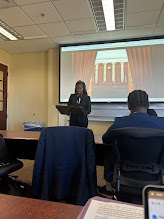The massacre in Charleston at Mother Emanuel church occurred when a 21 year old drop out with deep hatred for African Americans went to the church and attended bible study before opening fire. The hatred that fueled this violent act dates all the way back to the Reconstruction era at the end of the Civil War.
During the Reconstruction era, violence was an accepted part of life and worked in tandem with Jim Crow laws. It all began when Robert E Lee surrendered at Appomattox to Ulysses Grant and ended the Civil War. Newly freed slaves began to scatter, but there was still a question as to how they were supposed to start new lives.Ulysses S Grant treated the blacks as equal citizens because he knew that having black soldiers was essential to ensure the war ended in abolition, but once it actually ended African Americans' status as citizens was put into question. People began to walk to the places where they had last seen their family members and many posted newspaper ads to try to find them. The 13th amendment was passed in Congress, but it had yet to be ratified by many states.
President Abraham Lincoln was a big part in ensuring Reconstruction had a positive ending, but when he gave a speech about giving black men the right to vote, many people were in opposition. Shortly after that speech, Lincoln was assassinated by John Wilkes Booth. President Andrew Johnson was sworn in not long after Lincoln died and took Reconstruction in a different direction.President Johnson set up new state governments in the south and gave them complete authority over the black populations to control them in any way they saw fit. At the time President Johnson was sworn in, Congress was not in session so he had complete control.
Many efforts like the Freedmen's Bureau and 40 acres and a mule took wrong turns when Johnson took office. President Johnson ordered Major General Oliver Howard to take the land given in 40 acres and a mule and return it back to the white confederates. This meant many slaves had nowhere to go and were forced into labor contracts with their past owners simply so they could make enough money to survive.
Racism was the deepest legacy of slavery and it was not going to be wished away simply because the 13th amendment had been passed. Many different laws and regulations were passed like the Black Codes and the Vagrancy laws which only applied to black citizens and forced them back into submission. The white planter class even had the authority to take children from "unfit" parents and put them under apprenticeship where they would be used for their labor and there was no protection from abuse.
The Klu Klux Klan was also created in Tennessee around the same time as the Black Codes. This group acted similar to the slave patrol, but this time controlling freed blacks. Families were often targeted by the klan if they were well off economically or if their children were in school.Under Johnson, many white confederates forced their way back into Congress where they could once again destroy freedom and equality for the black community. Thaddeus Stevens and other House Republicans called for change and the clerk ignored all southern delegates when calling roll, meaning they were no longer part of Congress. After this Congress passed the Civil Rights Act of 1866 over President Johnson's veto, which established birth right citizenship.
Over the next few months riots broke out in towns like Memphis and New Orleans. Many soldiers came back from war with weapons they had bought from the government which resulted in mounted tensions. Confederates went on the hunt and burnt down many houses and churches. Terror went on in Memphis for 3 days before the army gained control. When mobs broke out in New Orleans, many people realized Johnson's Reconstruction plan was not working because he gave black citizens no rights.
The 14th amendment was passed shortly after, redefining rights. This included the law that no state could deny due process and equal protection to any citizen. This also stated that every person born in the United States would be a citizen.In order to get states to pass the 14th amendment, they were divided into five military districts which was ruled by generals who forced confederate states to create new laws and constitutions. This also allowed black men to not only vote, but also to hold office. The southern states were told that if these new laws were not passed, the would not be allowed to re-enter the union. This was slightly controversial at the time because not even northern states also black men to vote at this time. At the time, Tennessee was the only southern state still in the union.
While Reconstruction originally appeared to be a failure, changes to the Constitution may not have been made without the original failed attempts. Within a decade, freedmen went from being slaves to being established into political society. Although it was not a journey without many road blocks.

















